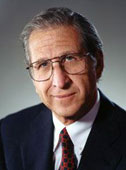Mending Hearts and Building Bridges

Bernard Goldman
|
When Bill Bigelow introduced
Bernie Goldman to leaders of
cardiovascular surgery such as
Michael DeBakey and Denton
Cooley in the 1960s, he communicated
a sense of the dynamic
momentum of the specialty and
a sense of history in the making.
Bernie had been fascinated by
cardio-pulmonary physiology as
a medical student - he considered
internal medicine or surgery as a career choice. After
a rotation in California on a surgical service, he chose
surgery, based on its pace and the opportunity it offered
to fix the pathology he had been studying.
Toronto Surgical Chair Fred Kergin directed him into
cardiac surgery. His significant mentors were Bigelow,
Bill Mustard, Bruce Tovee, Griff Pearson and David
Bohnen. They ensured that he travelled with the
McLaughlin Fellowship, studying with Ronald Belsey
in Bristol, England, and with Gerry Austen and Mort
Buckley at the Massachusetts General Hospital. Bigelow
also sent him to Cleveland, Palo Alto and Houston to
bring new techniques back to Toronto. On his return,
Bernie worked with Al Trimble to introduce coronary
artery bypass.
In addition, he practiced vascular surgery at Mount Sinai
Hospital. At that time, vascular surgery was an important
part of cardiovascular surgical practice, including
peripheral, aortic, carotid and portacaval surgery. He
also introduced support of the failing heart with the
intra-aortic balloon pump, a technique he had learned
in Boston.
During his years at Toronto General Hospital he was
supported and encouraged by Ron Baird. He enjoyed
these years with partners Richard Weisel, Tirone David
and Hugh Scully.
He followed the teaching techniques of Bruce Tovee,
Griff Pearson and Bill Mustard - partnering with residents
in the OR and ward. Their influence led Bernie to
become a devoted teacher and colleague of his residents.
He contributed to the training of most of the cardiac
surgeons in Toronto and throughout the entire country.
In addition, he trained ten cardiac surgeons currently
practising in Israel. Like Norman Shumway, Mustard
and Tovee, Bernie was a master first assistant who could
develop the skills and confidence of his surgical residents
from the opposite side of the table. He received the
Tovee Award for Post Graduate teaching and many other
accolades from former residents.
The deluge of coronary surgery in the 1970s overwhelmed
the available facilities at Toronto General and St. Michael's
Hospital. After 20 years at Toronto General, Bernie was
asked to set up a cardiac service at Sunnybrook. University
chairman Bernie Langer made sure that the new service at
Sunnybrook would not be limited to the role of a coronary
mill, but would take on all cardiovascular cases and train
|
residents. The early success and remarkably low mortality
established the Sunnybrook centre in the constellation of
the University of Toronto's cardiac surgery program. The
leaders of the institution at that time, Martin Barkin,
Marvin Tile and Al Harrison helped to assure success.
They set a "can do and must do" tone, developing a sense
of pride in the institution as a complete academic centre
which had been evolving from a Veterans' Hospital into a
Trauma Centre.
The Sunnybrook surgeons, particularly Bernie, George
Christakis and Steve Fremes developed a reputation as
excellent teachers. Eventually, Bernie was asked to serve
as chief of surgery at Sunnybrook. He encouraged orthopedics
and neurosurgery to work together as a spinal
surgery team and helped Fred Brenneman, then training
at Cook County Hospital in Chicago, to establish and
lead a world class trauma service at Sunnybrook. Bernie
continued operating until age 70. He continued writing,
editing, educational and other activities. He had
a special interest in training surgeons and cardiologists
to insert pacemakers and defibrillators correctly. As he
began to withdraw from major operative surgery, he
wrote insightfully about retirement. His thoughts on this
subject were captured in an earlier issue of the Spotlight.
(Musings by Bernard Goldman - The Surgical Spotlight,Winter 2004-2005: 5-6, University of Toronto)
Bernie took on the responsibility of editing the Journal
of Cardiac Surgery, raising its citation index and circulation
significantly. With funding support from Medtronic
Inc, he and his co-editor, Susan Belanger from the
Department of History of Medicine, published a very
successful history of cardiac surgery in Canada, now in
its second edition (Heart Surgery in Canada: Memoirs,
Anecdotes, History and Perspective) He has supported
philanthropic causes in Israel, including chairmanship
of Save a Child's Heart, a program that provides cardiac
surgical care at no cost to children from Africa, China,
Eastern Europe and the Middle East. They have so far
done 2400 operations in Israel on children from 33
countries; 50% of them are from neighbouring Arab
countries. The theme of the organization is "mending
hearts and building bridges". They recently celebrated
the treatment of their 1000th Palestinian patient. Bernie
went to the West Bank city of Nablus this past fall to
see post-operative patients. His busy fund-raising efforts
have been very generously helped by a grateful Toronto
patient.
The Bernard S. Goldman Chair in Cardiac Surgery has
recently been established and filled by his distinguished
successor as chief of cardiac surgery at Sunnybrook,
Steve Fremes. In celebration of Bernie's contributions to
his country as well as his specialty he was recently designated
a Member of the Order of Canada.
Bernie's wife Fran is a musician, choir master and linguist;
his son, Richard, is an expert in banking law and
computers in Boston; his daughter, Kathy, is a singer
and songwriter, currently studying at both Harvard and
Boston University; his youngest daughter, Sari, a social
worker and new mother, lives in Toronto. Bernie currently
chairs a Ministry of Health working group on
standalone angioplasty centres and serves on a surgical
panel at The College of Physicians and Surgeons of
Ontario.
M.M.
|